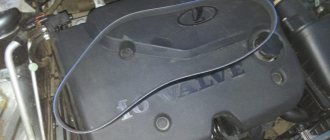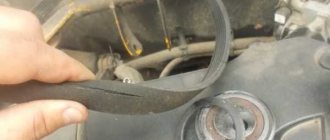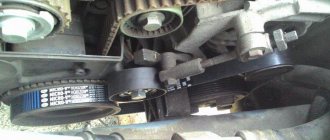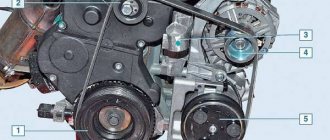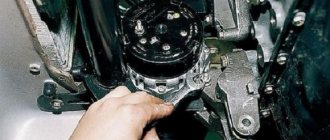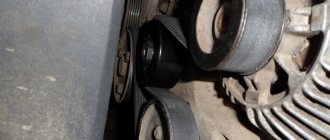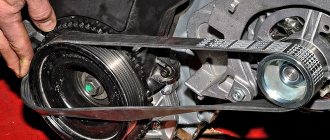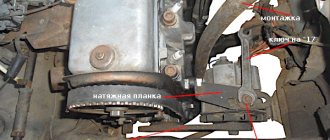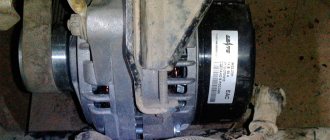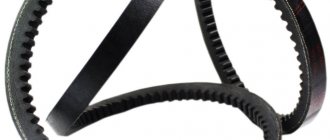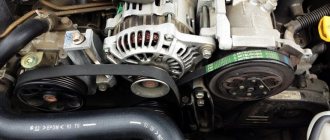The Lada Priora, created on the basis of the VAZ 2110 sedan, belongs to the family of Russian small cars. The model was produced in various configurations with different drives for auxiliary units.
For example, the base model has a conventional alternator belt tensioning mechanism. At the same time, in cars equipped with air conditioning or power steering (power steering), the trajectory of the alternator belt is slightly different.
Accordingly, replacing the alternator belt on a Priora without air conditioning is a little easier than on a Priora with air conditioning. Let's consider the algorithm for replacing a belt with different types of drive.
Tensioning the alternator belt: a guide for car enthusiasts
The distinctive features of the Priora from previous modifications of the manufacturer are noticeable immediately, literally as soon as we open the hood. Here the new owner of the Lada will have to learn a lot again. This seemingly not very complicated procedure, which allows you to tighten the alternator belt in a Priora car to the required limit, will require considerable effort.
The peculiarity of new car models is that the ability to choose a car equipped with optional equipment is already present as standard. So in the “base” “Priora” can already be equipped with power steering or air conditioning.
Naturally, driving the car becomes even more convenient, but the recompense for comfort in this model is a more complex design of the generator belt drive. After all, the belt itself on a Priora car, which has air conditioning or power steering, is significantly longer, has a more complex trajectory, is serviced and replaced according to completely different rules.
Tensioning the alternator belt in a Priora car - nuances of implementation
Any car enthusiast knows that there will definitely come a time when you need to tighten the Priora alternator belt. It is known that the belt drive of this car is quite durable, but during operation there is a slight stretching of the belt itself, as well as a decrease in the adhesion of its surface to the pulley and roller.
Literally as soon as you notice a whistling alternator belt on a Priora, you need to start tightening it at the same moment, especially since this is not difficult to do.
Before tensioning the Priora generator belt, you need to prepare an open-end or socket wrench for 19 and a special two-end tension wrench directly for the roller. This key is similar to the one used to change discs on an angle grinder.
Generator malfunctions and ways to eliminate them
There aren't many problems. They come in two main varieties.
Type of faults
Signs
The generator and battery always work together. For the battery, the generator is the only autonomous power source, which allows it to remain as a backup power source for the on-board network when the generator is not working. In turn, by constantly recharging the battery, the generator makes it possible to start the engine at any time.
Generator malfunctions do not occur out of nowhere; there are usually preconditions for breakdowns. And the owner has the opportunity to correct the malfunction in a timely manner. Otherwise, the generator will need to be repaired on Priora.
Difficulty starting the engine
Problems with starting the propulsion system directly indicate problems with the generator. If it malfunctions, the battery experiences a constant lack of charge, which means it does not have enough power to rotate the engine flywheel through the starter. A discharged battery is the main result of a generator breakdown. A malfunction of this device can result not only from a lack of charge, but also, conversely, from overcharging. Such phenomena arise due to the failure of the relay regulator, i.e., current is generated in much larger volumes. This leads to boiling of the electrolyte in the battery banks and, as a consequence, to failure of the battery.
Checking the tension of the alternator belt on a Priora
Owners of a Priora car can know how to tension the alternator belt from numerous sources on the Internet and by reading the relevant literature. After all, any car enthusiast will learn how to properly tighten the alternator belt on a Priora from these sources, and not through the transfer of experience from other car enthusiasts. But some “tricks” associated with checking tension cannot be found even in the above sources. Let's take a closer look at them.
If you press on the belt at the longest interval directly between the pulleys, then its deflection should be within 8-12 mm, but this rule is only suitable for a very modest car configuration. After all, if the car is equipped with power steering or air conditioning, the belt then has a different trajectory, which helps reduce the area of interaction between the belt and the pulleys.
To make up for the lack of contact, you will need to tighten the belt on the Priora a little more. If it is not possible to use the services of a specialist, then you can try adjusting the tension of the Priora generator belt “by ear”. If the tension is insufficient, the belt will definitely slip, making a wild “whistle”, and if the tension is too strong, the generator bearings will hum.
Bearings
ATTENTION! A completely simple way to reduce fuel consumption has been found! Don't believe me? An auto mechanic with 15 years of experience also didn’t believe it until he tried it. And now he saves 35,000 rubles a year on gasoline! Read more". First of all, experts see the reason in the bearing
Apart from him, there is nothing to hum there. Although in some cases the diode bridge may also produce a hum. You should know that the more consumers are involved in the car, the more difficult it is for the generator to turn. The load on the bearings automatically increases
First of all, experts see the reason in the bearing. Apart from him, there is nothing to hum there. Although in some cases the diode bridge may also produce a hum. You should know that the more consumers are involved in the car, the more difficult it is for the generator to turn. The load on the bearings automatically increases.
As you know, generator bearings are installed for easy rotation of the rotor armature. One of the bearings is placed in the front cover, the other is pressed onto the rotor. It is noteworthy that both bearings are pressed, so replacing them is not so easy.
As a rule, if the bearings fail, then in addition to the hum, the battery is no longer charged.
Experts recommend paying attention to the nature of the hum. If it resembles a whistle and is heard mainly under the hood, then it’s clear that the bearing is worn out
Before replacing bearings, you should find out what brand they are. If they are domestically produced, they are inexpensive. The price of imported spare parts is much higher.
The service charges at least 600-700 rubles for the work of replacing bearings. But this can be done with your own hands.
Replacement is carried out as follows:
- the car engine turns off;
- the belt is removed;
- the wiring is dismantled, the generator is unscrewed and removed;
- disassembling the generator begins with removing the rear plastic cover;
- brushes and relays are removed;
- the diode bridge is dismantled, which should be freed from 3 screws;
- Next, the front part is disassembled, the rotor is carefully clamped in a vice, and the pulley is removed;
- the front cover with the bearing is removed;
- the rear bearing is pressed from the armature (a puller is used).
Tensioning the timing belt on a Priora: user instructions
In addition to the alternator belt in a Priora car, another important component is the timing belt. For this reason, many car enthusiasts are wondering how to tighten the timing belt on a Priora? It is not difficult to carry out this procedure; it is enough to prepare a tool: a “5” hexagon, a “17” and “15” head.
Before tightening the Priora timing belt, you should:
— unscrew the two screws securing the cover;
— remove the bottom cover covering the timing drive;
— insert the tips of the pliers into the grooves of the outer race of the tension roller in order to remove the locking rings.
- tighten the belt by turning the tension roller directly with pliers, counterclockwise.
— these actions are performed until the cutout of the outer race is aligned with the rectangular protrusion of its inner sleeve;
— after the above steps, the roller mounting bolt is tightened with a wrench;
— we check that the marks on the camshafts and crankshaft are aligned, as well as the cutout matches the mark on the tension roller. If the marks do not match, you should repeat the operation to tension the timing belt.
How to tension a roller
After replacement or dismantling and subsequent return to place, the roller must be adjusted for proper operation of the drive mechanism. To work you will need tools:
- Size key
- Special key for tightening. It is a structure welded to the base in the form of a pair of rods with a gap of 18 mm between them (similar to a key for an angle grinder). The rods are designed for insertion into technological holes on the roller.
How should the belt be tensioned?
- The eccentric roller retaining bolt must be loosened.
- Clamp the roller cage and turn the part counterclockwise or clockwise with the adjuster key, increasing/decreasing the belt tension. At the longest section between the pulleys and the shaft, it should bend by about 6 mm.
When the desired result is achieved, the fastening is finally tightened.
ALTERNATOR BELT TENSION ROLLER FOR VEHICLES WITH STEERING OR AIR CONDITIONING
The Priora, equipped with various options, has an alternator belt more than a meter long. It passes through four reference points. Three of them are pulleys. The first is the engine drive pulley and the second is the generator and power steering pump or air conditioning compressor. The fourth point is the tension roller itself. This simple mechanism is made in the form of a regular rolling bearing, with an eccentric base. That is, when turning it around its axis, thanks to the hole for the bolt, located not in the center of the bearing, but offset to the edge, the protruding part can tighten or loosen the drive belt of all additional Priora mechanisms.
Principle of operation
When you turn the ignition on, current from the battery enters the field winding through the brush assembly, where a magnetic field appears. When the crankshaft rotates, the rotor goes into rotation. The magnetic field passes through the stator winding and an alternating voltage is generated at the output. Having reached a certain rotation speed, the excitation winding begins to be powered directly from the generator.
Basic faults
Why does the generator not charge the Lada Priora car? There may be several reasons:
- the diode bridge is damaged;
- the turns of the stator winding are closed;
- slip rings wear out;
- the pulley is damaged or worn out;
- the wires of the charging circuit are damaged;
- the bearing is destroyed or worn out;
- the voltage regulator is damaged;
- The current collecting brushes wear out.
In all of the above cases, repair of the Lada Priora generator will be required.
TENSIONER FOR PRIORA AND KALINA NOT EQUIPPED WITH OPTIONS
On the Priora, which does not have power steering or air conditioning, the belt is much shorter. It works on only two points: the crankshaft pulley and the generator pulley. The latest samples are equipped with a tensioning system similar to the VAZ Kalina. That is, if on other VAZ cars the tension is done by moving the generator itself, then on the Priora, a plastic roller of the tension system presses on the drive from above. A special tensioning mechanism is installed to move the roller. It consists of several parts:
The entire system is clearly visible in the photo. To adjust the drive and replace the tensioner, the following keys are needed. Slip on 19, end and socket on 13 and any wrench on 8. First, loosen the bolt and nut holding the movable platform with the roller with a wrench on 13. Then release the lock nut securing the adjusting rod using a wrench on 19. Using a wrench or socket on 8, unscrew the adjusting rod cravings The generator remains motionless. When the belt is loose, unscrew the bolt with the bushing on which the desired part is attached. Now remove the roller and install a new one in its place.
Check the free rotation of the tensioner for the generator drive and, having tightened the rod to the normal state of the drive, securely fix all the fasteners.
